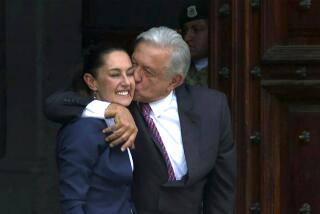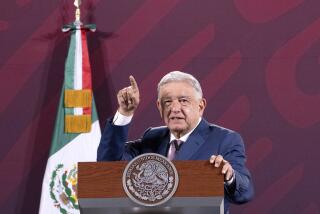Aquino Names Panel to Write a Constitution
- Share via
MANILA — Moving to anchor her revolutionary government in law, President Corazon Aquino on Sunday named a commission to draft a new constitution for the Philippines.
At a colorful rally marking three months in office, Aquino announced the 45-member panel and, “in the spirit of reconciliation,” invited “the opposition” to fill five additional spots. A presidential spokesman said later that Aquino was referring to loyalists of deposed President Ferdinand E. Marcos.
Plebiscite Planned
The commission will begin work June 2. Aquino said she hopes it will be finished within 90 days. The proposed constitution will then be submitted to a national plebiscite. If it is approved, legislative elections could be held by the end of the year or early in 1987.
The commission members were drawn from an initial list of about 1,000 names nominated by various sectors of Philippine society. They represent a range of occupations--politicians, lawyers, clergy, labor leaders and educators. None is an officeholder. Six of the 45 are women.
Several were active in Aquino’s campaign for the Feb. 7 presidential elections--Cecilia Munoz-Palma, a former justice and member of Parliament; Francisco Rodrigo, a former senator, and Father Joaquin Bernas, president of the Roman Catholic Ateneo University and author of many of Aquino’s important campaign speeches.
The list also includes Lino Brocka, a leftist film director jailed briefly by Marcos last year, and Bernardo Villegas, a noted economist. There had been speculation that Aquino might name a Communist to the panel, but no known Communists were on the list.
The rally was held at Camp Aguinaldo, the armed forces headquarters, where a military revolt led by Defense Minister Juan Ponce Enrile and the armed forces chief of staff, Gen. Fidel V. Ramos, combined with a popular uprising that drove Marcos from power Feb. 25.
“Three months ago, we gathered here in tens of thousands and faced down a dictatorship,” Aquino declared. “Now we must must begin a second struggle--to breathe life into a dead economy and give enduring form to our newly won freedom.”
Aquino has ruled under what she called a “freedom constitution,” which she proclaimed after taking office. She set a one-year deadline for governing under the provisional document, which gives her the power to legislate by decree. Elections early next year would meet her deadline.
Election Option
The constitution-writing process has been a divisive issue, with many politicians and lawyers, including some of Aquino’s own supporters, insisting that the commission should have been elected instead of appointed.
Justice Minister Neptali Gonzalez insisted that there was no time for elections to a constitutional convention if Aquino was to meet her deadline.
Now the focus will turn to the contents of the constitution. The major issues include:
--The form of government: an American-style presidential system or a parliamentary system. After Marcos declared martial law here in 1972, the government was a mix of the two systems.
--Federalism versus a strong central government. Several sectors, particularly the Muslim minority in this overwhelmingly Catholic country, have called for greater autonomy under a federal system.
--Foreign military bases. Opponents of the big U.S. bases here have said that they will push for a constitutional provision banning any foreign military presence. Others oppose raising the issue.
‘35 Constitution
There is strong support for a document along the lines of the 1935 constitution, which established a presidential system with a two-house legislature. Philippine nationalists, however, discredit that document as a “colonial constitution,” for it was written when the Philippines was an American commonwealth.
A new constitution was written under Marcos in 1973, a creation of martial law that gave the president extraordinary powers. Aquino abolished the 1973 document when she proclaimed her provisional constitution.
As Aquino was announcing her commission Sunday, several thousand Marcos loyalists met across town and, by voice vote, proclaimed Arturo Tolentino, Marcos’ vice presidential running mate in the February elections, acting president of the Philippines. Tolentino addressed the loyalists and labeled Aquino’s government “unconstitutional and illegal,” but he declined to take an oath as acting president.
Oliver Lozano, a lawyer and organizer of the loyalist rally, said Marcos had told him by telephone from Hawaii to go through with the proclamation.
The Aquino rally marked the third day of public appearances by the 53-year-old president. On Friday and Saturday, on her first trip outside the island of Luzon since taking power, she visited the cities of Davao and Cebu.
‘Recharging Batteries’
The trip was described by acting Mayor John Osmena of Cebu as an opportunity “to recharge her batteries.”
Another Aquino supporter suggested that the trip was intended to demonstrate her continued popularity and constituted a message to some military factions that question the strength of her control of the government.
Military issues were raised at both stops. In Davao, she called on Ramos to justify the use of paramilitary troops against insurgents. He and other military leaders insist that the paramilitary units are a necessary first line of defense against the Communist-led insurgency. Presidential spokesmen said Saturday that Aquino will give a hearing to the military’s insistence that the paramilitary issue be examined case by case.
In Cebu, where she met with local groups and addressed a rally, Aquino called for the public to support the armed forces. She also appeared to be appealing for moderation among her followers in their efforts to punish Marcos loyalists and some military men for past abuses.
“If ever we are to get our nation going, all of us will just have to forgive and forget,” she told a news conference.
More to Read
Sign up for Essential California
The most important California stories and recommendations in your inbox every morning.
You may occasionally receive promotional content from the Los Angeles Times.













